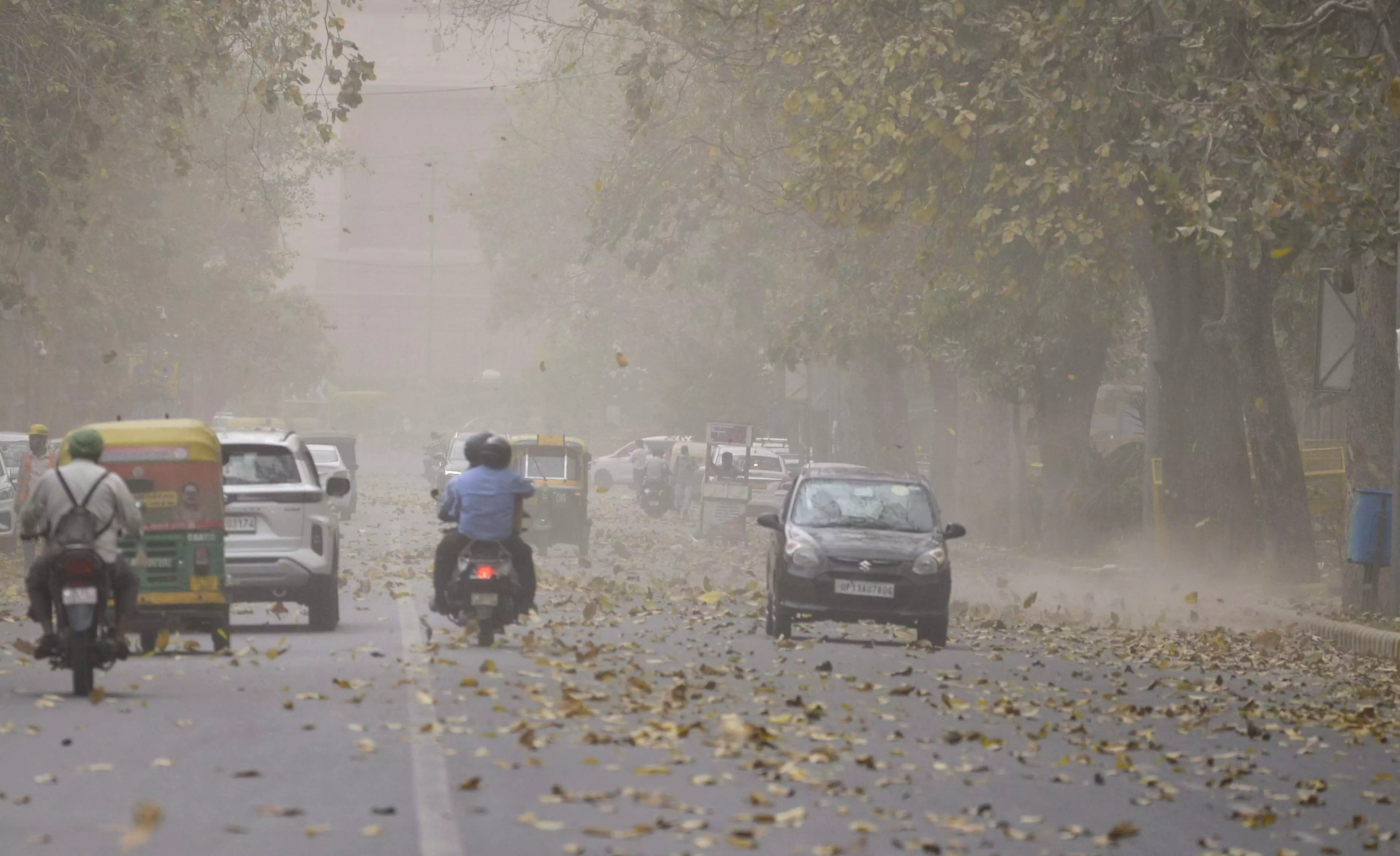Strong Winds Lash Delhi NCR; Trees, Poles, and Sheds Topple in Noida

The third consecutive day of turbulent weather in the region with strong winds and dust storms swept across Delhi and its neighboring cities like Noida and Ghaziabad on Saturday afternoon. Heavy rain and strong gusts brought traffic to a halt in several areas and caused significant damage.
In Noida, powerful winds uprooted trees that crashed onto parked vehicles, while a traffic light pole at DM Chowk also came down during the storm. At the Rapid Rail Metro’s Ashok Nagar station, the roof of a passenger shed was torn apart by the wind. Meanwhile in central Delhi’s Connaught Place, a large tree fell near PVR Plaza, damaging cars after a sudden thunderstorm rolled in.
The India Meteorological Department (IMD) had forecast thunderstorms and light to moderate rain for Delhi on Saturday, with the city’s maximum temperature predicted to hover around 42°C. The sudden change in weather and reduced visibility earlier in the week was attributed to dust storms originating in North Pakistan, which the IMD said were being carried into the capital via Punjab and Haryana by strong westerly winds.
At around 3:30 pm Saturday, the IMD issued another alert, warning of an impending dust storm followed by thunderstorms and light rain in the next two hours across all of Delhi-NCR. Gusty winds reaching speeds of 40 to 60 km/h were expected to continue.
This bout of rough weather follows similar conditions on Friday, when several parts of Delhi—including Rohini, Bawana, Burari, and Delhi University—experienced rain, lightning, and strong winds. Noida and other NCR areas were also hit. Wind speeds on Friday ranged from 30 to 60 km/h, and some light showers were recorded in scattered areas.
Rainfall figures from the IMD showed 1.4 mm at Safdarjung (the city’s primary weather station), 7.2 mm in Aya Nagar, and smaller amounts in Ridge, Pusa, and Pitampura. The southeastward movement of a weather system from Rohtak is expected to continue, bringing more rain and gusty winds to southeast Delhi.
Despite the rainfall, the heat hasn’t let up. Delhi recorded a high of 42.3°C on Saturday—about 2°C above the seasonal average. Aya Nagar peaked at 44°C, Palam at 43.3°C, and the Ridge area at 43.2°C. The minimum temperature remained slightly below normal at 26.2°C.
In the wake of the worsening weather and a sudden spike in air pollution caused by the dust, the Commission for Air Quality Management (CAQM) reinstated Stage-I measures of the Graded Response Action Plan (GRAP) across Delhi-NCR on Friday. After the Air Quality Index (AQI) saw a sharp decline due to dust-laden winds, the decision came in.
Strong winds and dust storms swept across Delhi and its neighboring cities like Noida and Ghaziabad on Saturday afternoon, marking the third consecutive day of turbulent weather in the region. Heavy rain and strong gusts brought traffic to a halt in several areas and caused significant damage.
In Noida, powerful winds uprooted trees that crashed onto parked vehicles, while a traffic light pole at DM Chowk also came down during the storm. At the Rapid Rail Metro’s Ashok Nagar station, the roof of a passenger shed was torn apart by the wind. Meanwhile in central Delhi’s Connaught Place, a large tree fell near PVR Plaza, damaging cars after a sudden thunderstorm rolled in.
The India Meteorological Department (IMD) had forecast thunderstorms and light to moderate rain for Delhi on Saturday, with the city’s maximum temperature predicted to hover around 42°C. The sudden change in weather and reduced visibility earlier in the week was attributed to dust storms originating in North Pakistan, which the IMD said were being carried into the capital via Punjab and Haryana by strong westerly winds.
At around 3:30 pm Saturday, the IMD issued another alert, warning of an impending dust storm followed by thunderstorms and light rain in the next two hours across all of Delhi-NCR. Gusty winds reaching speeds of 40 to 60 km/h were expected to continue.
This bout of rough weather follows similar conditions on Friday, when several parts of Delhi—including Rohini, Bawana, Burari, and Delhi University—experienced rain, lightning, and strong winds. Noida and other NCR areas were also hit. Wind speeds on Friday ranged from 30 to 60 km/h, and some light showers were recorded in scattered areas.
Rainfall figures from the IMD showed 1.4 mm at Safdarjung (the city’s primary weather station), 7.2 mm in Aya Nagar, and smaller amounts in Ridge, Pusa, and Pitampura. The southeastward movement of a weather system from Rohtak is expected to continue, bringing more rain and gusty winds to southeast Delhi.
Despite the rainfall, the heat hasn’t let up. Delhi recorded a high of 42.3°C on Saturday—about 2°C above the seasonal average. Aya Nagar peaked at 44°C, Palam at 43.3°C, and the Ridge area at 43.2°C. The minimum temperature remained slightly below normal at 26.2°C.
In the wake of the worsening weather and a sudden spike in air pollution caused by the dust, the Commission for Air Quality Management (CAQM) reinstated Stage-I measures of the Graded Response Action Plan (GRAP) across Delhi-NCR on Friday. The decision came after the Air Quality Index (AQI) saw a sharp decline due to dust-laden winds.
Authorities are urging residents to stay indoors during high wind periods, avoid parking vehicles under trees, and stay updated with official weather alerts as erratic conditions are expected to persist.
Authorities are urging residents to stay indoors during high wind periods, avoid parking vehicles under trees, and stay updated with official weather alerts as erratic conditions are expected to persist.
